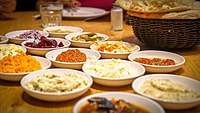Sfenj
Sfenj (from the Arabic word Arabic: السفنج, romanized: Safanj, meaning sponge) is a Maghrebi doughnut: a light, spongy ring of dough fried in oil. Sfenj is eaten plain, sprinkled with sugar, or soaked in honey. It is a well-known dish in the Maghreb and is traditionally made and sold early in the morning for breakfast or in the late afternoon accompanied by tea—usually Maghrebi mint tea—or coffee.[2] It is also called Khfaf[3] in Algeria and other parts of the Maghreb, bambalouni in Tunisia,[4] and sfinz in Libya.[5] Outside the Maghreb, sfenj is often eaten by Moroccan Jews and other Sephardim in Israel and elsewhere for Hanukkah.[6] Sfenj and other doughnuts are eaten for Hanukkah because they are fried in oil, commemorating the Hanukkah miracle wherein the oil that was supposed to light the lamp in the Temple in Jerusalem for only one day lasted for eight. Though sfenj can be made at home, as it usually is in Israel, Moroccans almost always opt to purchase it from street vendors or bakeries, where they are commonly strung on palm fronds.[7]
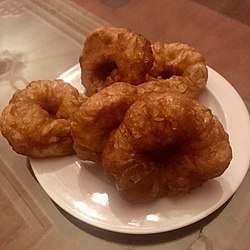 Sfenj in Marrakesh, Morocco | |||||||
| Alternative names | Bambalouni, khfaf, sfinz | ||||||
|---|---|---|---|---|---|---|---|
| Type | Doughnut | ||||||
| Place of origin | Maghreb | ||||||
| Main ingredients | Flour, water, sugar, yeast and salt | ||||||
| 137 kcal (574 kJ)[1] | |||||||
| |||||||
History
Sfenj originated in Al-Andalus, otherwise known as Muslim Spain. According to legend, sfenj was created by mistake, when a baker accidentally dropped a ball of dough into a pan of hot oil.[8] Sfenj was an important part of Andalusi culture, whose role was best summarized by a verse from a contemporary poet: "The sfenj bakers are worth as much as kings" ("سفاجين تحسبهم ملوكا").[9]
It is unclear how sfenj first spread to the Maghreb, although it is said that it was well known to the Banumarin Dynasty who originated in the Aurès region of Algeria and who ruled Morocco from 1270 to 1465. It also spread to France during the 13th century, where it inspired beignets.[9]
Though sfenj comes from Al-Andalus, most bakers and sellers of sfenj in the Maghreb have traditionally been Amazigh (Berbers). The nomadic Amazigh are thought to have spread sfenj throughout the Maghreb aided in that by merchants who traveled across the region.[9]
Dedicated sfenj bakers, called sufnāj (سفناج), soon appeared throughout the Maghreb, attesting to the dessert's popularity. Sufnājeen (plural of sufnāj) became central figures in the social life of Maghrebi neighborhoods, as they interacted with almost every household in their community every morning, and working as a sufnāj was considered a respectable career. In a traditional sfenj bakery, the sufnāj (and their large circular fryer) sit on an elevated platform, raised slightly above the rest of the bakery, which is already raised more than a meter off the ground. Customers surround this platform and try to catch the sufnāj's attention to place their orders by raising their hand at him or her in a manner reminiscent of the Nazi salute and shouting. For this reason, sufnājeen are often nicknamed "Hitler" (هتلر).[8][9]
Traditional sufnājeen are quickly going extinct in the modern Maghreb, as a result of the rise of industrial bakeries and the proliferation of sfenj recipes over the Internet.[8]
Sfenj were only sweetened with sugar starting in the 18th century, even though sugarcane has been widely cultivated in the Arab world since the 8th century. Before that, they were sweetened with honey or syrup, or simply served plain.[9]
Sfenj in Israel

Sfenj entered Israeli culture before 1948, as Maghrebian Jews brought it with them when they immigrated to Mandatory Palestine.[10] Sfenj quickly became popular for Hanukkah, as it is easy to prepare at home. However, sfenj's ease of preparation contributed to its loss of popularity in Israel. During the late 1920s, the Histadrut, Israel's national labor union, pushed to make the jelly-filled sufganiyah the traditional food of Hanukkah. Making sufganiyot well can only be done by professional bakers, and the Histadrut wanted sufganiyot to supplant easyly home-made latkes (potato pancakes) in order to secure jobs for Jewish bakers.[11] Their effort was successful: by 2016, Israel's 7 million Jews were eating 20 million sufganiyot per year, while few Israelis of non-Moroccan origin eat sfenj.[12] More Israeli Jews report eating sufganiyot for Hanukkah than fasting for Yom Kippur.[11][13]
Varieties
In addition to ordinary sfenj, there are two special varieties of sfenj, not counting the different toppings (honey, syrup, and sugar) sfenj can have:[8]
- Sfenj matifiyya (السفنج المطفية), sfenj that is pounded flat and then fried a second time.
- Sfenj matifiyya bil-baydh (السفنجة المطفية بالبيض), sfenj matifiyya with an egg added before refrying.
In language
Sfenj's importance to Moroccan culture is reflected in several idioms in Moroccan Arabic, including:[9]
- "Give someone a sfenj and he'll say it's ugly" (صاب سفنجة وقال عوجة), meaning "do not judge a book by its cover" or "do not bite the hand that feeds you."
- "As if hitting a dog with a sfenj" (ابحال إلى ضربتي كلب باسفنجة), meaning a futile or Sisyphean endeavor, especially an act of pointless petty revenge (because if someone hits a dog with a sfenj, the dog will eat and like it).
- "Demanding oil from a sufnāj" (اطلب الزيت من سفناج), meaning "taking from the needy" (because a sufnāj—a sfenj baker—uses large amounts of cooking oil).
Gallery
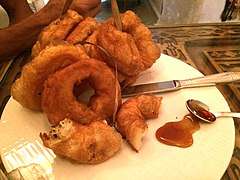 Sfenj in Essaouira Morocco. Sfenj are still bound together by passing a length of palm frond through the center as is pictured here.
Sfenj in Essaouira Morocco. Sfenj are still bound together by passing a length of palm frond through the center as is pictured here._sfenj.jpg) Method for making sfenj in Algeria
Method for making sfenj in Algeria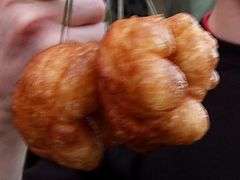 Sfenj in Morocco
Sfenj in Morocco Khfaf from Kabylie in Algeria
Khfaf from Kabylie in Algeria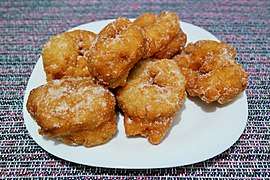 Sfenj sprinkled with sugar and served on a plate
Sfenj sprinkled with sugar and served on a plate
See also
- Arab cuisine
- Buñuelo, the Latin American equivalent
- Frittelle, the Italian equivalent
- List of doughnut varieties
- List of Moroccan dishes
- Sfinz
- Sufganiyah
- Zalabiyeh
References
| Wikimedia Commons has media related to Sfenj. |
- Benlafouih, Caroline. "Sfenj Recipe - Moroccan Doughnuts or Fritters". The Spruce Eats. Retrieved 31 May 2018.
- "Sfenj سفنج". طبخ.org (in Arabic). tabkh maghribi. 2012. Retrieved 31 May 2018.
- Scheherazade, Jawahir (24 November 2014). "Sfenj à la farine". Joyaux Sherazade (جواهر شهرزاد) (in French). Retrieved 1 June 2018.
- "Recette de Bambalouni - Sfenj". Chahia Tayba (in French). 2011. Retrieved 1 June 2018.
- Hamza, Umm (9 April 2015). "SFINZ / SFENJ". Halal Home Cooking. Retrieved 7 August 2018.
- Goren, Carine (11 October 2016). Traditional Jewish Baking: Retro Recipes Your Grandma Would Make... If She Had a Mixer. Page Street Publishing. pp. 176–178. ISBN 9781624142758.
- Koenig, Leah (12 December 2014). "A Moroccan Hanukkah Feast". The Tablet. Retrieved 31 May 2018.
- الرحالي, خديجة (7 October 2011). ""السفناج" مهنة عريقة في المغرب العربي في طريقها للاندثار". الشرق الاوسط (in Arabic) (12001). لندن. Retrieved 31 May 2018.
- أوالفقر, حسن (24 March 2004). ""الاسفنج" فطائر مغربية تحضر الى المائدة من بطون التاريخ!". الشرق الاوسط (in Arabic) (9248). لندن. Retrieved 31 May 2018.
- Kaufman, Jared (21 February 2018). "Never Underestimate The Doughnut Lobby". Roads & Kingdoms. Retrieved 31 May 2018.
- Green Ungar, Carol (Winter 2012). "The "Hole" Truth About Sufganiyot". Jewish Action. Orthodox Union. Retrieved 31 May 2018.
- Solomonov, Michael (1 December 2016). "Why Sfenj Couldn't Be the Official Dessert of Hanukkah". Food52. Retrieved 31 May 2018.
- Nachshoni, Kobi (13 September 2013). "Poll: 73% of Israelis fast on Yom Kippur". YNet. Retrieved 31 May 2018.
